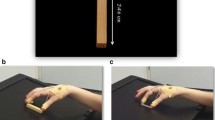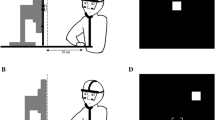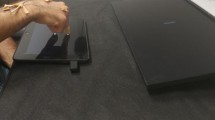Abstract
Virtual-reality and telerobotic devices simulate local motor control of virtual objects within computerized environments. Here, we explored grasping kinematics within a virtual environment and tested whether, as in normal 3D grasping, trajectories in the virtual environment are performed analytically, violating Weber’s law with respect to object’s size. Participants were asked to grasp a series of 2D objects using a haptic system, which projected their movements to a virtual space presented on a computer screen. The apparatus also provided object-specific haptic information upon “touching” the edges of the virtual targets. The results showed that grasping movements performed within the virtual environment did not produce the typical analytical trajectory pattern obtained during 3D grasping. Unlike as in 3D grasping, grasping trajectories in the virtual environment adhered to Weber’s law, which indicates relative resolution in size processing. In addition, the trajectory patterns differed from typical trajectories obtained during 3D grasping, with longer times to complete the movement, and with maximum grip apertures appearing relatively early in the movement. The results suggest that grasping movements within a virtual environment could differ from those performed in real space, and are subjected to irrelevant effects of perceptual information. Such atypical pattern of visuomotor control may be mediated by the lack of complete transparency between the interface and the virtual environment in terms of the provided visual and haptic feedback. Possible implications of the findings to movement control within robotic and virtual environments are further discussed.





Similar content being viewed by others
References
Afgin O, Sagi N, Nisky I, Ganel T, Berman S (2017) Visuomotor resolution in telerobotic grasping with transmission delays. Front Robot AI. https://doi.org/10.3389/frobt.2017.00054
Aglioti S, DeSouza JFX, Goodale MA (1995) Size-contrast illusions deceive the eye but not the hand. Curr Biol 5(6):679–685. https://doi.org/10.1016/S0960-9822(95)00133-3
Bingham G, Coats R, Mon-Williams M (2007) Natural prehension in trials without haptic feedback but only when calibration is allowed. Neuropsychologia 45(2):288–294. https://doi.org/10.1016/j.neuropsychologia.2006.07.011
Davarpanah Jazi S, Heath M (2016) Pantomime-grasping: advance knowledge of haptic feedback availability supports an absolute visuo-haptic calibration. Front Hum Neurosci 10:197
Foster RM, Franz VH (2013) Inferences about time course of Weber’s Law violate statistical principles. Vis Res 78:56–60. https://doi.org/10.1016/j.visres.2012.11.012
Freud E, Ganel T (2015) Visual control of action directed toward two-dimensional objects relies on holistic processing of object shape. Psychon Bull Rev 2003:1377–1382. https://doi.org/10.3758/s13423-015-0803-x
Freud E, Macdonald SN, Chen J, Quinlan DJ, Goodale MA, Culham JC (2018) Getting a grip on reality: grasping movements directed to real objects and images rely on dissociable neural representations. Cortex 98:34–48. https://doi.org/10.1016/j.cortex.2017.02.020
Ganel T (2015) Weber’s law in grasping. J Vis 15(18):1–2. https://doi.org/10.1167/15.6.1
Ganel T, Goodale MA (2003) Visual control of action but not perception requires analytical processing of object shape. Nature 426(6967):664
Ganel T, Chajut E, Algom D (2008) Visual coding for action violates fundamental psychophysical principles. Curr Biol 18(14):599–601. https://doi.org/10.1016/j.cub.2008.04.052
Ganel T, Freud E, Meiran N (2014) Action is immune to the effects of Weber’s law throughout the entire grasping trajectory. J Vis 14(7):1–11. https://doi.org/10.1167/14.7.11.doi
Gonzalez CLR, Ganel T, Whitwell RL, Morrissey B, Goodale MA (2008) Practice makes perfect, but only with the right hand: sensitivity to perceptual illusions with awkward grasps decreases with practice in the right but not the left hand. Neuropsychologia 46(2):624–631. https://doi.org/10.1016/j.neuropsychologia.2007.09.006
Goodale MA, Milner AD (1992) Separate visual pathways for perception and action. Trends Neurosci 15(I):20–25. https://doi.org/10.1016/0166-2236(92)90344-8
Goodale MA, Jakobson LS, Keillor JM (1994) Differences in the visual control of pantomimed and natural grasping movements. Neuropsychologia 32(10):1159–1178
Heath M, Mulla A, Holmes SA, Smuskowitz LR (2011) The visual coding of grip aperture shows an early but not late adherence to Weber’s law. Neurosci Lett 490(3):200–204
Heath M, Holmes SA, Mulla A, Binsted G (2012) Grasping time does not influence the early adherence of aperture shaping to Weber’s law. Front Hum Neurosci 6:332
Helfenbein ED, Zhou SH, Lindauer JM, Field DQ, Gregg RE, Wang JJ, Michaud FP (2006) An algorithm for continuous real-time QT interval monitoring. J Electrocardiol 39(4):S123–S127
Holmes SA, Heath M (2013) Goal-directed grasping: the dimensional properties of an object influence the nature of the visual information mediating aperture shaping. Brain Cogn 82(1):18–24. https://doi.org/10.1016/j.bandc.2013.02.005
Holmes SA, Mulla A, Binsted G, Heath M (2011) Visually and memory-guided grasping: aperture shaping exhibits a time-dependent scaling to Weber’s law. Vis Res 51(17):1941–1948. https://doi.org/10.1016/j.visres.2011.07.005
Hosang S, Chan J, Jazi DS, Heath M (2016) Grasping a 2D object: terminal haptic feedback supports an absolute visuo-haptic calibration. Exp Brain Res 234:945–954. https://doi.org/10.1007/s00221-015-4521-4
Jakobson LS, Goodale MA (1991) Factors affecting higher-order movement planning: a kinematic analysis of human prehension. Exp Brain Res 86(1):199–208
Jarmasz J, Hollands JG (2009) Confidence intervals in repeated-measures designs: the number of observations principle. Can J Exp Psychol 63(2):124–138. https://doi.org/10.1037/a0014164
Jazi SD, Hosang S, Heath M (2015) Memory delay and haptic feedback influence the dissociation of tactile cues for perception and action. Neuropsychologia 71:91–100
Jeannerod M (1984) The timing of natural prehension movements. J Mot Behav 16(3):235–254
Johansson RS, Flanagan JR (2009a) Coding and use of tactile signals from the fingertips in object manipulation tasks. Nat Rev Neurosci 10(5):345
Johansson RS, Flanagan JR (2009b) Sensory control of object manipulation. In: Hermsdorfer J, Nowak DA (eds) Sensorimotor control of grasping: physiology and pathophysiology. Cambridge Univ. Press, Cambridge, UK
Magdalon EC, Michaelsen SM, Quevedo AA, Levin MF (2011) Comparison of grasping movements made by healthy subjects in a 3-dimensional immersive virtual versus physical environment. Acta Physiol (Oxf) 138(1):126–134
Milner AD, Goodale MA (2008) Two visual systems re-viewed. Neuropsychologia 46(3):774–785. https://doi.org/10.1016/j.neuropsychologia.2007.10.005
Mishkin M, Ungerleider LG (1982) Contribution of striate inputs to the visuospatial functions of parieto-preoccipital cortex in monkeys. Behav Brain Res 6(1):57–77. https://doi.org/10.1016/0166-4328(82)90081-X
Mon-Williams M, Dijkerman HC (1999) The use of vergence information in the programming of prehension. Exp Brain Res 128(4):578–582. https://doi.org/10.1007/s002210050885
Ozana A, Ganel T (2017) Weber’s law in 2D and 3D grasping. Psychol Res. https://doi.org/10.1007/s00426-017-0913-3
Ozana A, Ganel T (2018) Dissociable effects of irrelevant context on 2D and 3D grasping. Atten Percept Psychophys 80:564–575. https://doi.org/10.3758/s13414-017-1443-1
Schenk T (2012) No dissociation between perception and action in patient DF when haptic feedback is withdrawn. J Neurosci 32(6):2013–2017
Tresilian JR, Mon-Williams M, Kelly BM (1999) Increasing confidence in vergence as a cue to distance. Proc R Soc Lond B 266(1414):39–44. https://doi.org/10.1098/rspb.1999.0601
Wann JP, Mon-Williams M, McIntosh RD, Smyth M, Milner DA (2001) The role of size and binocular information in guiding reaching: insights from virtual reality and visual form agnosia III (of III). Exp Brain Res 139(2):143–150
Whitwell RL, Milner AD, Cavina-Pratesi C, Byrne CM, Goodale MA (2014) DF’s visual brain in action: the role of tactile cues. Neuropsychologia 55:41–50
Whitwell RL, Ganel T, Byrne CM, Goodale MA (2015) Real-time vision, tactile cues, and visual form agnosia: removing haptic feedback from a “natural” grasping task induces pantomime-like grasps. Front Hum Neurosci 9:216. https://doi.org/10.3389/fnhum.2015.00216
Acknowledgements
This study was supported by an Israel Science Foundation (ISF) Grant 274/15 to Tzvi Ganel and to Daniel Algom and by the Helmsley Charitable Trust through the Agricultural, Biological and Cognitive Robotics Center of Ben-Gurion University of the Negev.
Author information
Authors and Affiliations
Corresponding author
Ethics declarations
Conflict of interest
The authors declare that they have no conflict of interest.
Rights and permissions
About this article
Cite this article
Ozana, A., Berman, S. & Ganel, T. Grasping trajectories in a virtual environment adhere to Weber’s law. Exp Brain Res 236, 1775–1787 (2018). https://doi.org/10.1007/s00221-018-5265-8
Received:
Accepted:
Published:
Issue Date:
DOI: https://doi.org/10.1007/s00221-018-5265-8




